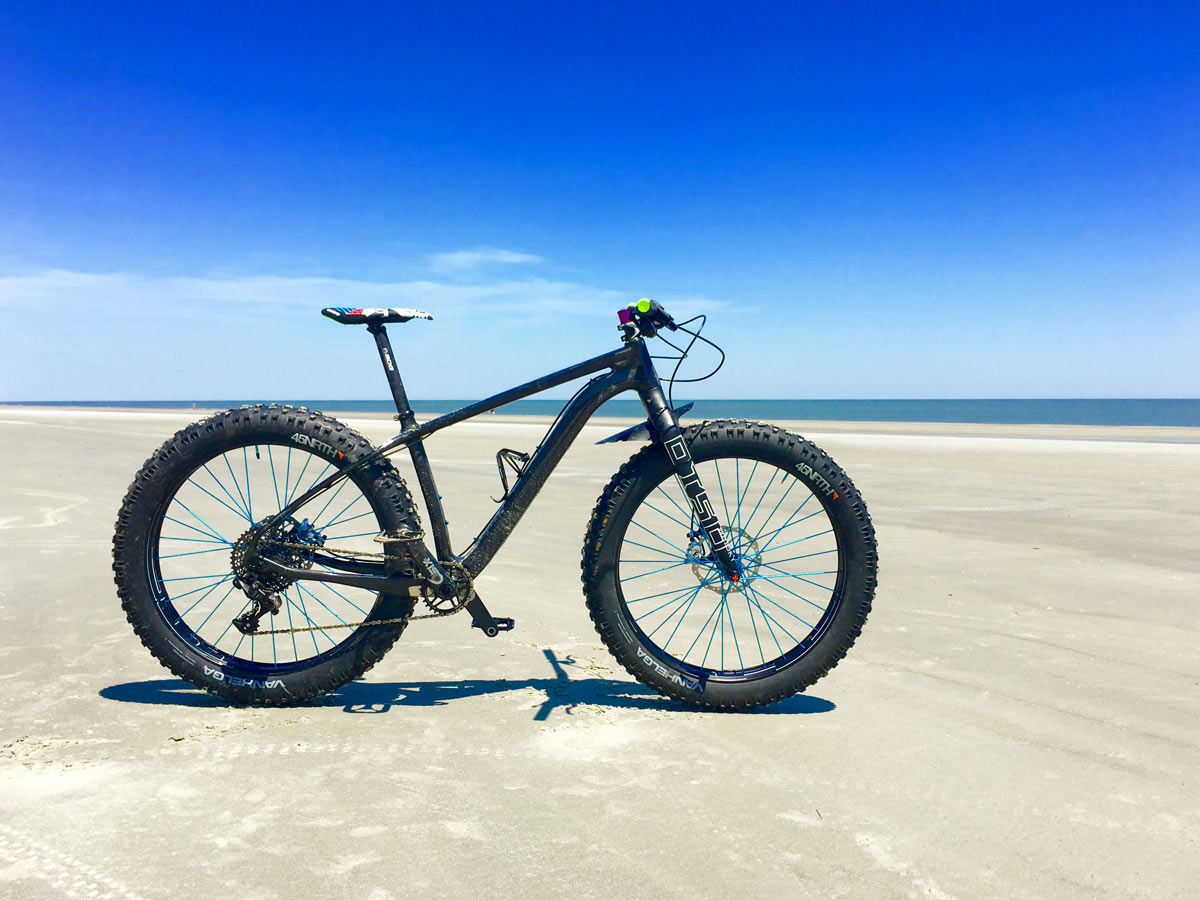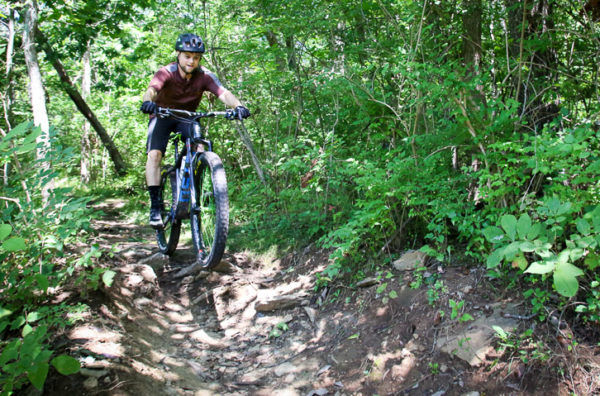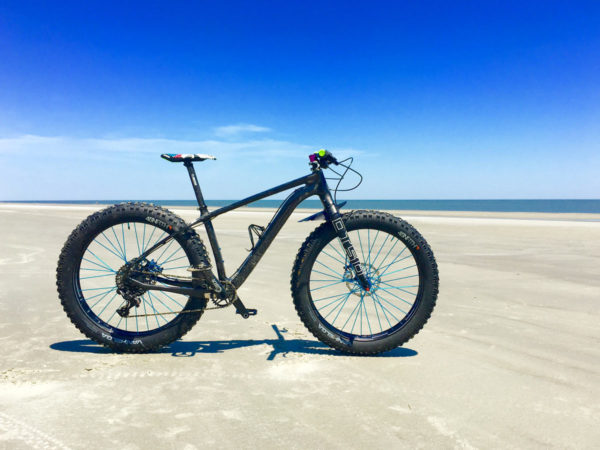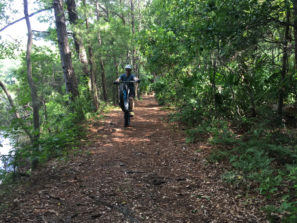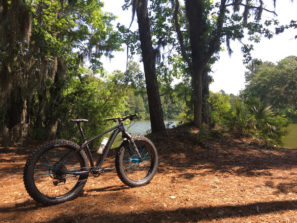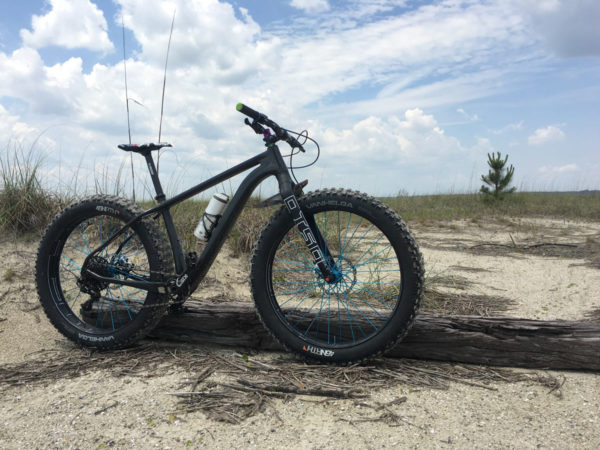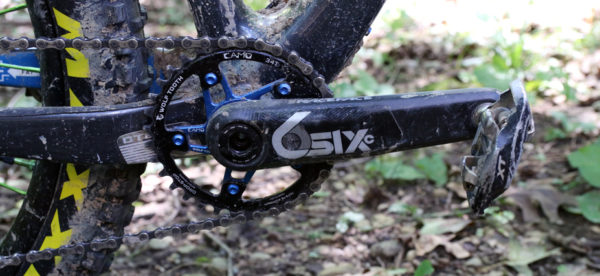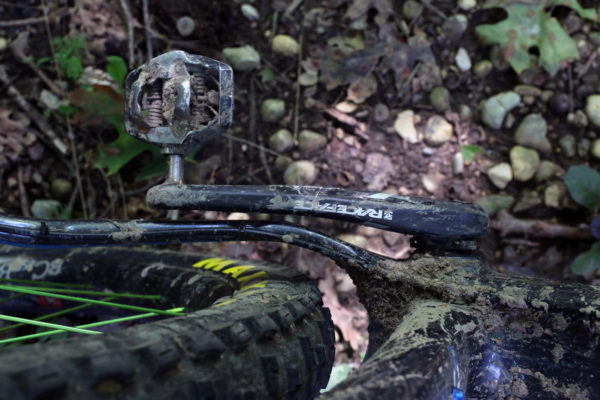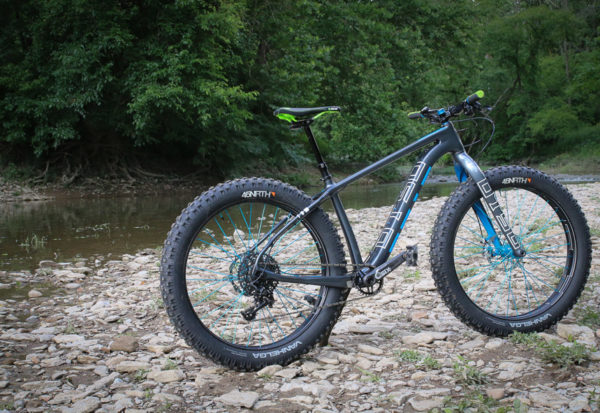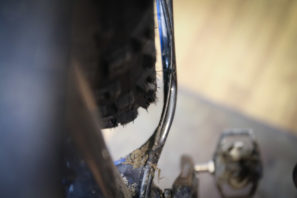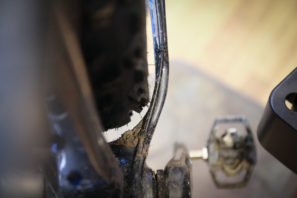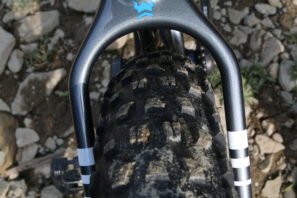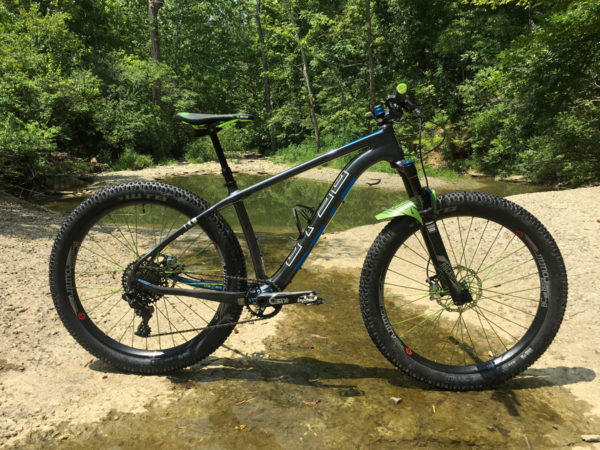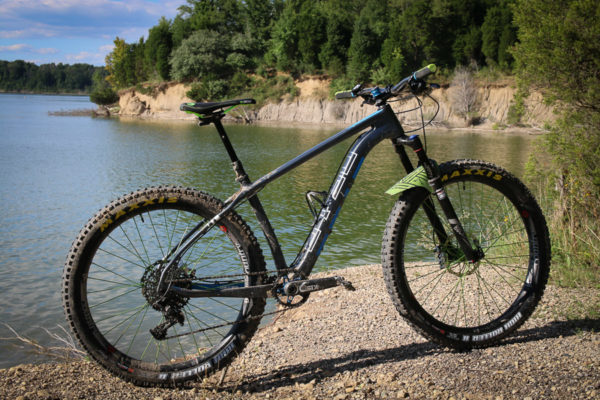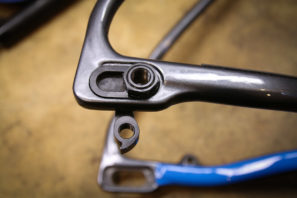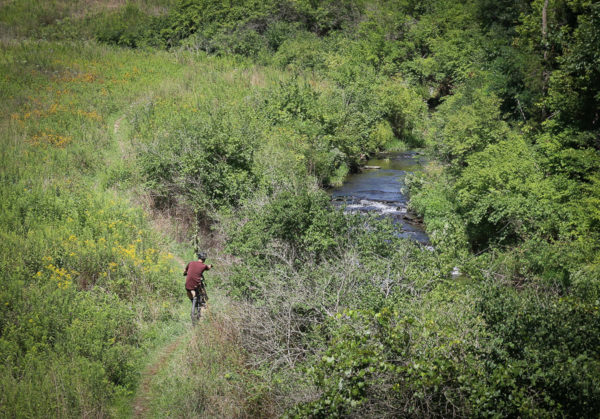When the crew from Wolf Tooth Components first told me about their Otso project, I was instantly intrigued. Fat bikes are getting better than ever, but a large majority of the population still struggles with the idea of a “one season bike” – even if that isn’t really true. Now that plus bikes, especially hard tails, are gaining in popularity, could the Otso be the ultimate plus/fat hybrid? More importantly, plus bike aside, would the clever design of the Voytek create an even better fat bike?
I couldn’t wait to find out (literally)…
When the gears started turning for this review build, it was April, and I was looking forward to spending a week at the beach with family and friends in May. This would probably be my best chance to get some true fat bike testing in on the Otso before the official release of the bike, and my first test mule literally came together at the vacation house. In order to get a bike rolling, Otso initially sent me a prototype frame that was completely blacked out with an Otso branded Whisky fork. Industry Nine and Magura get huge credit as well with Magura overnighting me the MT Trail brakes straight from Sea Otter, and Industry Nine building up the BigRig 760 wheels just in time for me to pick them up on my way through Asheville. Somehow, everything came together at the last minute and I’m so glad it did.
Yes, I know the hot patches don’t line up with the valves – all I had to seat the tires was a Bontrager Flash Charger, which was a huge struggle with the HED BAD rims. After finally getting them to pop into place, I wasn’t about to worry.
Summer beach fat biking is still one of my favorite ways to pass the time at the waterfront, especially when there is miles of coastline and inland trails to explore. Immediately, the work Otso put into reducing the Q factor was noticeable. I had brought a few other fat bikes along for the trip – a 9Zero7 Whiteout with the widest fat bike cranks available, and a Fatback Skookum, with the “narrow” fat bike crankset. Both were an extreme departure from the svelte profile of the Voytek. Wide Q factor is something that fat bikers have had to live with as tires started to get wider and wider, but now that I’ve had the taste of something narrower that still fits relatively wide tires, I’m not sure I can go back.
Another big draw for the Voytek in fat bike mode is the ability to run 430mm chainstays which are shorter than most other bikes on the market (by 10mm or so). Combined with stiff wheels, narrow Q factor, and the carbon frame, the Voytek brings fat bike handling to a new level.
Especially when combined with the short chainstays in shortest position for the Tuning Chip dropout system, the Voytek just feels like an entirely new breed of fat bike. Initially I wasn’t sure it was going to make that big of a difference, but it seems like it does. If you haven’t read the first two posts (here and here), the Voytek uses a PF107 shell which is the equivalent of an 83mm threaded bottom bracket rather than the PF121/100mm threaded BBs used in most fat bikes. That allows for the use of a narrower spindle for the RaceFace Cinch crank system, and a Q Factor of 183mm rather than 203mm or larger. I should note that actual Q factors will vary based on which cranks you run. The higher end carbon cranks from RaceFace have a 6mm narrower Q number than the aluminum Aeffect cranks, so if you’re looking for the narrowest possible this is the place you want to upgrade.
Because the crank is narrower, the rear end is narrower as well with a 177×12 rear hub which was sort of the fat bike standard before 5″ tires came along. The Voytek will still fit fairly large tires (more on that below), but it isn’t meant to fit the widest 5″ rubber on the market.
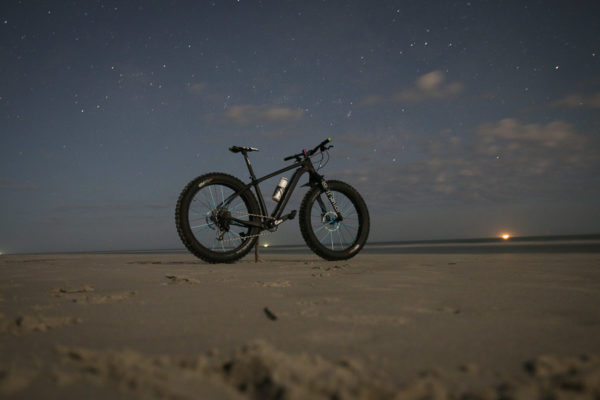
It’s hard to separate the performance of the frame from the wheels, but the combination of the Voytek and the Industry Nine BigRig 760s makes for a rocket of a fat bike. If you’re into fat bike racing, this is probably the bike to have. Realistically, there are better bikes for fat bike touring or true back country adventuring or racing with bigger tire clearance and more mounts for racks and bags, but for a lot of us, the Voytek will be plenty of bike. As the fat bike race platform of choice for Wolf Tooth Components, the bike has already seen race duty in both the Iditarod Trail Invitational and Arrowhead 135.
It wasn’t long until a new box showed up. This was the same bike, just a new finish – or actually finished. Otso has two options – carbon and grey for the stealthy crowd, or this deep grey and light blue if you want to get colorful. I went with the blue, because, why not? The anodizing of the Industry Nine turquoise wheels and blue of the Magura MT Trail brakes is a little off, but it’s close enough that you have to be super close to notice. I’m usually on a medium frame at 5’8″, and the Voytek is no different. After starting with a 70mm stem which was too long, I went to a 50mm, and then settled on a 60mm with 760mm bars. Otso says they went with a more modern long and low geometry for the Voytek, and it fits with the choice of stems.
The duration of fat bike testing up to this point has been with 45NRTH Vanhelga 4.0″ tires on the 76mm internal HED BAD rims. Otso lists tire clearance as 4.6″ though, so I had to check. In the top two photos above I have mounted a 45NRTH Dunderbeist to the HED BAD rim, which is probably one of the biggest 4.6″ tires you’ll find in terms of cornering knobs. With the Tuning Chip in the shortest position the knobs just barely clear the chainstays (top, right). I probably wouldn’t ride it like this for fear of it rubbing after knocking a wheel out of true, but you could – only the little hairs on the tire touch. At top, left, the Tuning Chip is in the longest position, which provides more clearance. It is still tight, but should be enough to safely ride. The middle chip position should also be a good fit for the 4.6″ crowd ( I don’t have the middle chip yet), and may even offer more tire clearance for the knobs based on the curvature of the chainstay and where the knobs will sit. At the bottom is the same rim with a 45NRTH Vanhelga 4.0 mounted in the shortest position.
Clearance at the seat stays is also fairly tight, especially with the 4.6″ Dunderbeist mounted, but it should be enough. I plan on revisiting this review with a winter version once the snow flies so I’ll have a better answer on how the bigger tires perform on this bike.
Home from the beach, it was time for the other part of the test – Voytek plus. Once upon a time, I thought building a set of plus wheels that would fit my current fat bike would be the perfect way to extend the season. What I found was that the increase in Q factor made it awkward to switch back and forth between it and my full suspension bike and left different muscle groups sore as they were forced into different pedaling positions.
The Voytek is intriguing because of the ability to run plus not only with the narrower Q factor, but the ability to modify the geometry through the Tuning Chip system and the fork. While the fat bike fork is suspension corrected around 100mm of travel, Otso recommends 120mm travel suspension forks with the plus builds to raise the BB and slack out the HTA.
Initially, I built the bike with WTB Trail Boss 27 x 3.0″ tires on the Industry Nine BackCountry 450 wheels and while the tires performed very well, the BB felt a little high.
Fortunately, Maxxis had just sent out a set of the new High Roller II in a 27 x 2.8″ size that fit the bike perfectly. Really, you could run either size, which part of the crazy versatility of this bike. Moving the Tuning Chip from the front to the center or rear position lowers the bottom bracket from 58-62mm, so you’d have a lower BB, bigger tires, and longer stays which would probably fit the adventurous nature of the bigger tires better anyways.
With the Tuning chip in the front position, the fork at 120mm, and 27 x 2.8″ tires, the Otso Voytek feels a lot like many other high end plus hardtails, which is kind of the point. It doesn’t feel like a fat bike that you swapped the wheels out. Instead it feels like a purpose built plus bike that hides the wider Q factor and rear hub extremely well. In fact, the wider (for a plus bike) Q factor is only noticeable if you jump on another bike right after riding the Otso. I will say that the racing background of the Wolf Tooth Components/Otso crew shows in the ride of the Voytek. This is a stiff frame that is built for performance. If light and stiff aren’t top criteria for your next build, you might want to look into something made from metal. But that also means that the handling of the Voytek can be dialed in to rip through the trees. The chainstays aren’t extremely short by modern plus hardtail standards, but in the 430mm position they are short enough to give the bike needed snap around corners and makes it easy to pop up the front end.
To me, the real draw of the Voytek is how much of a standout it is in fat bike guise. Performance wise, it’s unlike any other fat bike I’ve ever ridden. The fact that you’re getting a completely functional plus bike in the same package is an exceptional bonus that should keep you from hanging the Voytek in the back of your garage as the trails start to thaw.
